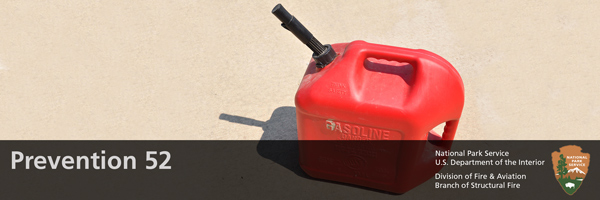
Warm weather is here, folks, and it's going to be another year of balancing busy days at the park and spending time with your friends and families. Maybe you're hitting the road to see our great country, enjoying long summer days gardening and barbecuing in the backyard, or protecting our parks on the fire line enjoying those splendid MREs. Regardless of how you spend your summer, one thing is for certain, using portable gas cans at home or work is most likely inevitable.
Weed whackers, lawn mowers, power washers, chainsaws, fire pumps--the list could go on forever. Small engine-driven equipment runs almost exclusively on gasoline, and that gasoline comes from portable gas cans. (Yes, "from dinosaurs" is also a correct answer.) After years of use, these portable gas cans may be missing a lid, have rust holes, or even have huge dents, making them unsafe.
Use only Underwriters Laboratories (UL) listed gasoline safety cans. Using non-UL-listed containers to store and transport gasoline is a really bad idea. That old milk jug or Tupperware container might not melt from the gas, but it doesn't keep the liquid or vapors contained, which could lead to a spill or combustion.
Portable gas cans have the ability to make good days turn terribly wrong when filled, stored, and transported improperly. It is up to all of us to use situational awareness around gasoline every day. With these helpful hints, we can work safely with gasoline:
Equipment Refueling
- Shut off the motor and give time to cool before refueling.
- Don't refuel near an open flame or near a sparking situation.
- Keep a fire extinguisher nearby.
- Don't spill the fuel.
- Don't overfill the fuel tank. On hot days, allow for expansion.
- Stay safe. Use only approved gas cans.
Filling Portable Gas Cans Safely
It is really important that we use extreme caution when filling portable gasoline cans from a pump. Gasoline is an extremely volatile refined product. It can catch fire, explode, and burn rapidly. Cutting the grass or using that power washer can wait until we follow these simple tips from Chevron Oil Company:
- Use only approved and properly labeled gasoline containers. The gas can should be red and have an Underwriters Laboratories (UL) or American Society for Testing and Materials (ASTM) stamp on it.
- Place the container on the ground before filling, and make sure the filler nozzle touches the rim of the filler opening to help static electricity dissipate.
- Fill the container only 95 percent full. Leave an air space so the fuel can expand as temperatures increase.
- Always fill the can manually; never use the trigger lock on the nozzle.
- Turn off your car's motor before fueling and extinguish any cigarettes or open flames.
- Never fill a container inside a vehicle or truck bed.
- Wipe the can clean before putting it in the vehicle (or hose it off).
- Secure the can in the vehicle so it won't slide around. Do not transport container in passenger compartment of vehicle.
- Never leave a gas can in your vehicle for extended periods.
Don't breathe gasoline fumes. They are extremely harmful to your health.
Fire Info for You
Firefighters
On the fireline, always make sure that gasoline is controlled and that no personal protective equipment is contaminated.
Take Action
- Inventory all of your portable gas cans. Make sure that they are in good condition and have all of the manufacturer's parts installed.
- If cans look like they have been in service since before Richard Nixon was president, replace them!
- After every shift, take the gas cans out of vehicle and secure them in a flammables locker or another secure location.
NPS Fire Facts
In just a three-year period, 2,400 gasoline fires occurred in homes, killing 110 people and causing $105.9 million dollars in property damage, according to the National Fire Protection Association. Most of the fires occurred from fuel spills, using gasoline to kindle fires or when gasoline was stored too close to heat sources.
Last updated: October 20, 2016
